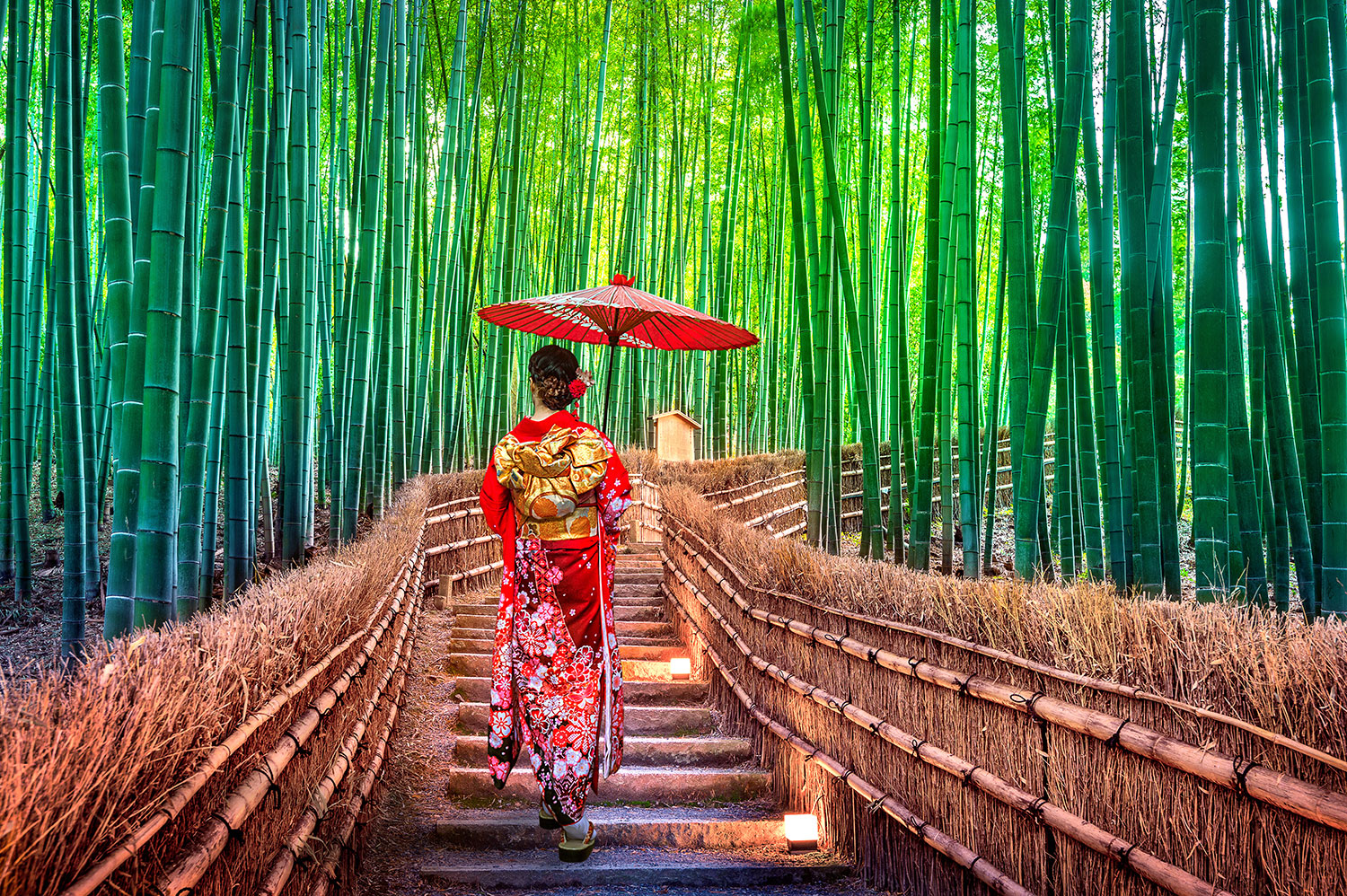

ARASHIYAMA – JAPANESE BAMBOO FOREST
Japanese bamboo myth
The Japanese are especially fond of mythical references and meanings. This also applies to bamboo. The plant very often appears in Japanese legends such as “The Tale of the Princess Kaguya”, found by an elder bamboo cutter in the illuminated tree stem. The similarities to this story are seen in the Danish Thumbelina.
In addition, bamboo is a symbol of longevity and durability. It used to be the basic building material in Japan. However, now buildings have to be more durable because of the earthquakes and typhoons that often affect the Land of the Rising Sun. But, to this day, windows, doors, fences, bridges and smaller utility items such as baskets, dishes or souvenirs are made from this tree. Therefore, bamboo still plays an important role in the local community, to which it is the main source of income.
Magic alley in the bamboo forest
There are around 130 species of bamboo in the world. As many as 50 of them can be found in one Japanese forest. When entering the famous bamboo forest, you can be a bit disappointed, as you do not see them right away. You need to walk a few metres to be able to enjoy the magical landscape made up of long bamboo stems compacted at small distances from each other. They can measure up to 40 m, which makes it impossible to see their top. Looking up can sometimes make you feel dizzy. Photos often do not reflect the whole atmosphere of this place.
The Arashiyama forest has its own sound
Thousands of bamboo trees swayed by the wind with green leaves make a huge impression. Their flexibility allows them to rub against each other, so that you can hear a peculiar sound, reserved only for the grove in Arashiyama. The Japanese Ministry of the Environment entered this rustle on the list of 100 sounds of Japan.
Pedestrian traffic in the bamboo forest
The forest in Arashiyama is one of the most popular places in Japan, or even in the world. It is a destination for many adventurers. Afternoons in the peak period are not an oasis of peace. Crowds of tourists often make it impossible to take any commemorative photos without them in the background and can obstruct the entire avenue. You can walk there only along designated paths, so at some point a long pedestrian traffic jam is formed. To take full advantage of the peace and charm of this place, go there early in the morning. Then the park is empty and you can admire the views and feel its natural climate.
Forest in film production
The beauty of the bamboo landscape is often used on photo wallpapers, decorative paintings, and even as the main motif on clothes and Japanese souvenirs. The forest in Arashiyama was often used in Japanese anime. A car was allowed to go along the main avenue of the park for a scene in the film “Memoirs of a Geisha”.
Togetsukyō – one of the most popular bridges in Japan
Apart from the most famous Japanese forest, the most well-known district of Kyoto features a crossing over the Hozu River on one of the most popular Japanese bridges. Togetsukyō (渡月橋) is known for its spectacular scenery. Its wooden 155-metre structure fits perfectly into the local landscape. It provides amazing views up and down the river against the background of spring cherry blossoms, summer greenery or varied colours of the autumn. The variety and abundance of colours used to attract many artists to the bridge, who tried to capture nature on canvases. Today, it is one of the most often photographed places in Kyoto.
The bridge is also an important place for the initiation of local children. Boys and girls dressed in kimono first perform a ritual in the temple and to receive a blessing. The next point of the ceremony is going through Togetsukyō. During the walk the participants cannot look back, as the superstition says that it brings misfortune in life.
Around the bamboo grove
Apart from the famous forest, Arashiyama has a lot to offer. On the sidewalks there are stalls with handicraft items made of bamboo. In many places your walk accompanied by musicians, who also make sounds using bamboo instruments. You can visit the park of macaques, the co-called snow monkeys. They are also known for their fondness for bathing in hot springs. On the nearby hillside of Mt. Ogura is the villa of the popular Japanese actor Okochi Sanso. He was known mainly from war samurai films. The complex offers refreshments in a tea room and contemplation in the temple. In addition, from here you can see a beautiful panorama of the entire Kyoto and the nearby Hozu River. Many anglers meet to enjoy fishing by its channel. It is also possible to sail on a boat and feed the local koi (鯉), meaning carps.
When is the best time to visit the bamboo forest?
It’s best to go to the park in spring or autumn. Then the scenery is at its most beautiful. Because bamboo is an evergreen plant, Arashiyama can be visited throughout the year to enjoy the beautiful landscape regardless of the time of visit.
In December you can see the Hanatouro illumination there. At night, the entire area of Saga Arashiyama is illuminated. The 5 km-long highlighted pavement is very impressive. Lanterns are also put at the local Togetsukyō Bridge. In the forest, the lights run along the paths from the Nonomiya Shrine to the Okochi Sanso’s villa. The light falls directly on the bamboo stems and effectively emphasizes the local vegetation, creating a charming atmosphere.














